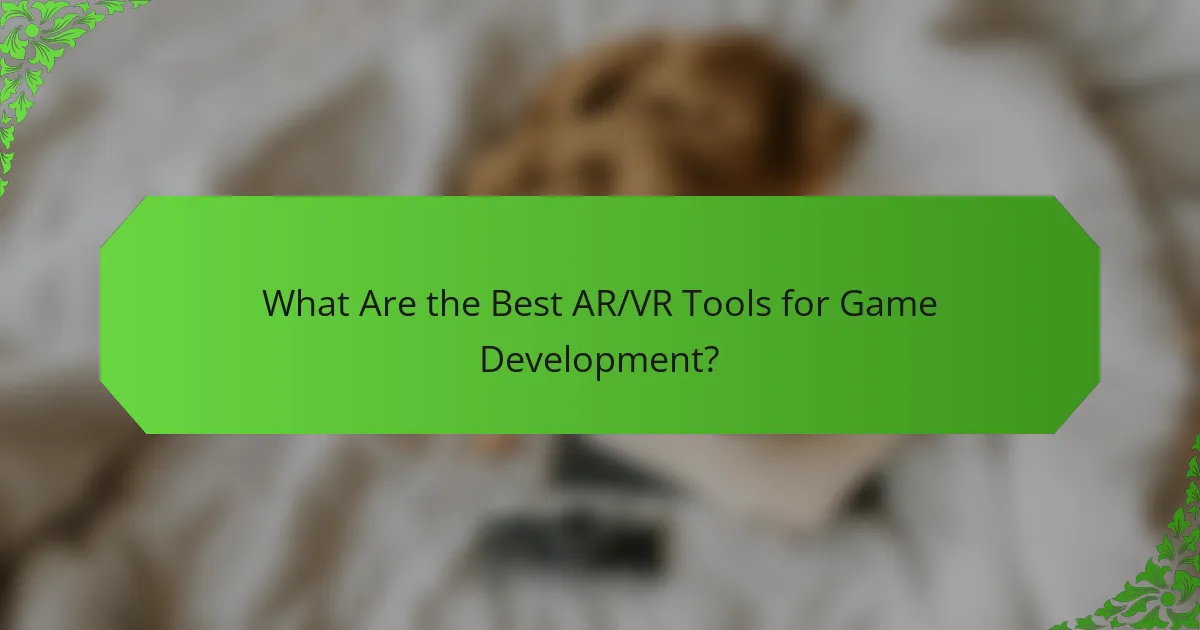Exploring the best AR/VR creative tools can significantly enhance your game development, design, and collaboration efforts. Platforms like Unity, Unreal Engine, and Blender offer diverse features tailored to various needs, enabling creators to craft immersive experiences. Additionally, these tools foster innovative thinking and teamwork, allowing users to visualize and interact with their ideas in dynamic three-dimensional spaces.

What Are the Best AR/VR Tools for Game Development?
The best AR/VR tools for game development include platforms that provide robust features for creating immersive experiences. Key options like Unity, Unreal Engine, Godot, Amazon Sumerian, and Blender cater to different needs, from high-end graphics to ease of use.
Unity
Unity is a leading game development platform known for its versatility and extensive asset store. It supports both AR and VR development, making it suitable for a wide range of projects, from mobile games to high-end console titles.
When using Unity, consider its user-friendly interface and strong community support. This can significantly reduce development time, especially for beginners. However, be mindful of performance optimization, as complex scenes can lead to lower frame rates.
Unreal Engine
Unreal Engine is renowned for its stunning graphics capabilities, making it a top choice for developers aiming for high-fidelity visuals in AR/VR. It utilizes a node-based scripting system called Blueprints, which simplifies the coding process.
While Unreal Engine excels in visual quality, it may have a steeper learning curve compared to Unity. Developers should also consider hardware requirements, as high-quality assets can demand more powerful systems, particularly for VR applications.
Godot
Godot is an open-source game engine that is gaining popularity for its lightweight design and flexibility. It supports both 2D and 3D game development, making it a good option for indie developers looking to create AR/VR experiences without significant costs.
One of Godot’s strengths is its scene system, which allows for easy organization of game elements. However, its AR/VR capabilities are still developing compared to Unity and Unreal, so it may not be the best fit for projects requiring advanced features.
Amazon Sumerian
Amazon Sumerian is a cloud-based platform designed for creating AR and VR applications without extensive programming knowledge. It integrates seamlessly with AWS services, making it ideal for developers looking to leverage cloud computing.
While Sumerian is user-friendly, it may lack some advanced features found in other engines. It’s best suited for simple AR/VR experiences and prototypes rather than complex game development.
Blender
Blender is primarily a 3D modeling and animation tool, but it also offers capabilities for creating AR/VR content. Its comprehensive features allow developers to design assets that can be exported to other game engines like Unity and Unreal.
Using Blender for AR/VR development can enhance the visual quality of your projects, but it requires a solid understanding of 3D modeling. Beginners should invest time in tutorials to master its interface and tools effectively.

How Do AR/VR Design Tools Enhance Creativity?
AR/VR design tools significantly boost creativity by offering immersive environments that allow creators to visualize and interact with their ideas in three dimensions. These tools facilitate innovative thinking and collaboration, making it easier to bring concepts to life.
Enhanced Visualization
Enhanced visualization in AR/VR tools allows designers to see their projects in a realistic context, which can lead to more informed decisions. For instance, architects can walk through a virtual building before it is constructed, identifying potential design flaws early on.
Using AR/VR, creators can manipulate 3D models in real-time, adjusting elements like color, texture, and scale. This immediate feedback loop helps refine ideas quickly, promoting a more iterative design process.
Interactive Prototyping
Interactive prototyping enables designers to create and test their concepts in a virtual space, providing a hands-on experience that traditional methods lack. This approach allows for rapid experimentation, where users can interact with prototypes to assess functionality and user experience.
For example, game developers can simulate gameplay mechanics in a virtual environment, allowing for immediate adjustments based on user feedback. This can reduce development time and costs, as issues can be identified and resolved before full-scale production.
Real-time Collaboration
Real-time collaboration in AR/VR platforms allows multiple users to work together regardless of their physical location. This feature is particularly beneficial for teams spread across different regions, as they can brainstorm and develop ideas in a shared virtual space.
Tools like Spatial and Mozilla Hubs facilitate this collaborative experience, enabling participants to interact with 3D models and provide feedback instantly. To maximize effectiveness, teams should establish clear communication protocols and designate roles to streamline the creative process.

What Are the Key Features of AR/VR Collaboration Tools?
AR/VR collaboration tools are designed to enhance teamwork and creativity in immersive environments. Key features include multi-user capabilities, cross-platform support, and integrated communication tools that facilitate seamless interaction among users.
Multi-user Environments
Multi-user environments allow several participants to interact within the same virtual space simultaneously. This feature is crucial for collaborative projects, enabling teams to brainstorm, design, and test ideas together in real-time.
When selecting a tool, consider the maximum number of users it supports and the stability of the experience. Tools that can accommodate dozens of users often provide a more dynamic and engaging collaboration experience.
Cross-platform Compatibility
Cross-platform compatibility ensures that users can access AR/VR tools across various devices and operating systems. This flexibility is essential for teams that use different hardware, such as VR headsets, smartphones, or PCs.
Look for tools that support popular platforms like Windows, macOS, iOS, and Android to maximize accessibility. This feature helps avoid barriers to participation and allows team members to join from their preferred devices.
Integrated Communication Tools
Integrated communication tools, such as voice chat and messaging, are vital for effective collaboration in AR/VR environments. These features enable users to share ideas and feedback instantly without needing to switch to external applications.
Choose tools that offer high-quality audio and video options to enhance interaction. Consider features like screen sharing or whiteboards, which can further enrich the collaborative experience by allowing users to visualize concepts together.

How to Choose the Right AR/VR Tool for Your Project?
Choosing the right AR/VR tool involves evaluating your project’s specific needs, budget constraints, and the skill levels of your team. A well-suited tool can enhance creativity and streamline the development process, while the wrong choice may lead to inefficiencies and increased costs.
Assessing Project Requirements
Start by clearly defining the goals and scope of your AR/VR project. Consider factors such as the target audience, desired platform (mobile, desktop, or console), and the type of experience you want to create—be it a game, educational tool, or marketing application. Each tool has unique features tailored to different project types.
Next, identify the technical requirements, including graphics quality, interactivity levels, and integration capabilities with existing systems. Tools like Unity or Unreal Engine may be ideal for high-fidelity graphics, while simpler platforms like A-Frame can suffice for basic applications.
Budget Considerations
Your budget will significantly influence your choice of AR/VR tools. Many professional-grade tools operate on a subscription model, with costs ranging from low monthly fees to several thousand dollars annually, depending on the features offered. Free or open-source options are available but may come with limitations.
Factor in additional costs such as hardware requirements, asset purchases, and potential training for your team. It’s wise to allocate a portion of your budget for unexpected expenses, as AR/VR projects can often exceed initial estimates.
Team Skill Levels
Assess the skill levels of your team members to ensure they can effectively use the chosen AR/VR tools. If your team is experienced in programming, they may prefer robust platforms like Unity or Unreal Engine, which offer extensive customization options. Conversely, if your team lacks technical expertise, user-friendly tools like CoSpaces or Spark AR might be more appropriate.
Consider providing training or resources to upskill your team if necessary. This investment can lead to better project outcomes and a more efficient development process. Avoid tools that are too complex for your team’s current capabilities, as this can lead to frustration and delays.

What Are the Pricing Models for AR/VR Creative Tools?
AR/VR creative tools typically follow two main pricing models: subscription-based pricing and one-time purchase. Each model has its own advantages and considerations, impacting how users access and utilize these tools for game development, design, and collaboration.
Subscription-based Pricing
Subscription-based pricing involves paying a recurring fee, usually monthly or annually, to access AR/VR creative tools. This model often includes regular updates, customer support, and access to a community of users, which can enhance the overall experience.
Common examples of subscription fees range from around $10 to $50 per month, depending on the tool’s features and capabilities. Users should consider their long-term needs, as subscriptions can add up over time, but they also provide flexibility and access to the latest tools without a large upfront investment.
One-time Purchase
One-time purchase pricing requires users to pay a single fee to own the software indefinitely. This model is appealing for those who prefer not to commit to ongoing payments and want full ownership of the tool.
Prices for one-time purchases can vary significantly, typically ranging from $50 to several hundred dollars. While this option eliminates ongoing costs, users may miss out on future updates and support unless they pay for upgrades. It’s essential to evaluate whether the tool meets current and future needs before making a purchase.